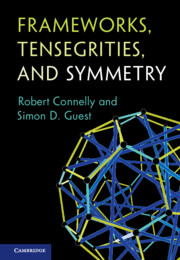Crossref Citations
This Book has been
cited by the following publications. This list is generated based on data provided by Crossref.
Nixon, Anthony
Schulze, Bernd
and
Whiteley, Walter
2021.
Rigidity through a Projective Lens.
Applied Sciences,
Vol. 11,
Issue. 24,
p.
11946.
Jordán, Tibor
and
Tanigawa, Shin-ichi
2022.
Rigidity of Random Subgraphs and Eigenvalues of Stiffness Matrices.
SIAM Journal on Discrete Mathematics,
Vol. 36,
Issue. 3,
p.
2367.
Xiao, Fan
Yang, Qingkai
Zhao, Xinyue
and
Fang, Hao
2022.
A Framework for Optimized Topology Design and Leader Selection in Affine Formation Control.
IEEE Robotics and Automation Letters,
Vol. 7,
Issue. 4,
p.
8627.
He, Zeyuan
and
Guest, Simon D.
2022.
On rigid origami III: local rigidity analysis.
Proceedings of the Royal Society A: Mathematical, Physical and Engineering Sciences,
Vol. 478,
Issue. 2258,
Micheletti, Andrea
and
Podio-Guidugli, Paolo
2022.
Seventy years of tensegrities (and counting).
Archive of Applied Mechanics,
Vol. 92,
Issue. 9,
p.
2525.
Gandikota, M. C.
Parker, Amanda
and
Schwarz, J. M.
2022.
Rigidity transitions in zero-temperature polygons.
Physical Review E,
Vol. 106,
Issue. 5,
Alexandrov, V. A.
2023.
On the Existence of Two Affine-Equivalent Frameworks with Prescribed Edge Lengths in Euclidean $ d $-Space.
Siberian Mathematical Journal,
Vol. 64,
Issue. 6,
p.
1273.
Dosmagulova, Karlygash
Mityushev, Vladimir
and
Zhunussova, Zhanat
2023.
On the Optimal Conductivity of Packed Two-Dimensional Dispersed Composites.
SIAM Journal on Applied Mathematics,
Vol. 83,
Issue. 3,
p.
985.
WANG, Changhong
and
CHEN, Jize
2023.
A high-mobility formation control method based on the principle of projective invariance.
SCIENTIA SINICA Informationis,
Vol. 53,
Issue. 10,
p.
1965.
Rocks, Jason W.
and
Mehta, Pankaj
2024.
Integrating local energetics into Maxwell-Calladine constraint counting to design mechanical metamaterials.
Physical Review E,
Vol. 110,
Issue. 2,
Owen, J.
and
Schulze, B.
2024.
Mobility of geometric constraint systems with extrusion symmetry.
Beiträge zur Algebra und Geometrie / Contributions to Algebra and Geometry,
Alexandrov, V. A.
and
Volokitin, E. P.
2024.
An Embedded Flexible Polyhedron with Nonconstant Dihedral Angles.
Siberian Mathematical Journal,
Vol. 65,
Issue. 6,
p.
1259.
Li, Kun
Wang, Yujuan
Jing, Gangshan
Song, Yongduan
and
Xie, Lihua
2025.
Angle Rigidity-Based Communication-Free Adaptive Formation Control for Nonlinear Multiagent Systems With Prescribed Performance.
IEEE Transactions on Cybernetics,
Vol. 55,
Issue. 2,
p.
500.
Yang, Qingkai
Zhang, Xiaozhen
Fang, Hao
Cao, Ming
and
Chen, Jie
2025.
Joint Estimation and Planar Affine Formation Control With Displacement Measurements.
IEEE Transactions on Control Systems Technology,
Vol. 33,
Issue. 1,
p.
92.
Chen, Jun
Chen, Muhao
Majji, Manoranjan
and
Skelton, Robert E.
2025.
Tensegrity system dynamics in fluids.
Nonlinear Dynamics,
Vol. 113,
Issue. 11,
p.
12971.
Klein, Jordan
Schad, Lorène
Malliavin, Thérèse E.
and
Müller, Martin Michael
2025.
Protein–membrane interactions with a twist.
Soft Matter,
Hain, Tyler
Santangelo, Chris
and
Manning, M. Lisa
2025.
Optimizing properties on the critical rigidity manifold of underconstrained central-force networks.
Physical Review E,
Vol. 111,
Issue. 1,
Scarr, Graham
2025.
Tensegrity Systems.
Vol. 2,
Issue. ,
p.
151.
Micheletti, Andrea
2025.
Tensegrity Systems.
Vol. 2,
Issue. ,
p.
1.
Oba, Ryoshun
and
Tanigawa, Shin‐ichi
2025.
Super stable tensegrities and the Colin de Verdière number ν <math xmlns="http://www.w3.org/1998/Math/MathML" altimg="urn:x-wiley:03649024:media:jgt23188:jgt23188-math-0001" wiley:location="equation/jgt23188-math-0001.png"><mrow><mrow><mi>\unicode{x003BD}</mi></mrow></mrow></math>.
Journal of Graph Theory,
Vol. 108,
Issue. 3,
p.
401.



